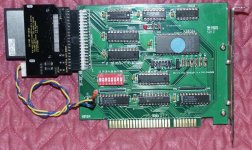mikerm
Experienced Member
Forgive me if I have missed this if the question had been asked before, but:
Has there been thoughts of a hard-card type form factor for these? It would be really cool if I could mount my laptop harddrive that I use on my XT-IDE right on the board instead of a weird place inbetween the floppies.
http://www.downloads.reactivemicro.com/Public/Apple II Items/Hardware/ZIP_DRIVE/Pics/Zip2.jpg (of course, just mounting holes for both desktop size and laptop size in this case).
Has there been thoughts of a hard-card type form factor for these? It would be really cool if I could mount my laptop harddrive that I use on my XT-IDE right on the board instead of a weird place inbetween the floppies.
http://www.downloads.reactivemicro.com/Public/Apple II Items/Hardware/ZIP_DRIVE/Pics/Zip2.jpg (of course, just mounting holes for both desktop size and laptop size in this case).




